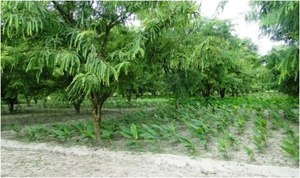 Aonla (Emblica officinalis) based agri-horticultural system has immense potential to utilize and conserve rainfed area for betterment of poor farmers. Perennial component (aonla) being a deep rooted and deciduous tree has a wide range of adaptability to grow in any type of soil and is considered a high tolerant potential fruit species suited to grow under salt-affected and wasteland/ravine lands with the little investments and higher economic return. Aonla (Emblica officinalis) based agri-horticultural system has immense potential to utilize and conserve rainfed area for betterment of poor farmers. Perennial component (aonla) being a deep rooted and deciduous tree has a wide range of adaptability to grow in any type of soil and is considered a high tolerant potential fruit species suited to grow under salt-affected and wasteland/ravine lands with the little investments and higher economic return. |
|
Tree Planting
|
|
| Establish an aonla orchard of cv. NA-7 at 6m x 6m spacing in 1 m3 pits filled with 20 kg well rotten farmyard manure, 100 g N, 50 g P2O5, and 75 g K2O. Provide life saving basin irrigation during summer months only at 15-20 days interval for first two years after planting and no irrigation from 3rd year. |
Intercroping and cultural practices
|
|
| Shade tolerant crops such as turmeric (Curcuma domestica, var. Rajendra Sonia), Ginger (Zingiber officinale, var. Nadia) and colocasia (Colocasia esculenta, var. Sahasramukhi) can be intercropped one meter away from the trunk leaving an area of 3 m2 around each tree. Well rotten compost @ 20 tonnes/ ha should be applied to the plots 15 days before sowing the intercrops. Nitrogen, phosphorus and potash should be applied as basal doses @ 120 : 50 : 100 kg ha-1 for turmeric, 60 : 50 : 80 kg ha-1 for ginger and 80 : 40 : 80 kg ha-1 for colocassia. The recommended spacings should be adopted for different crops, like turmeric and ginger, 30 cm x 20 cm and colocassia, 45 cm x 30 cm. Other cultural practices are as per recommendation of the crops. |
Yield and Economics
|
|
| Intercropping of 6 to 8-year-old aonla orchard increases the production of fruits significantly and it is maximum in Aonla in association with turmeric (13.30 tonnes/ha) followed by colocasia (11.71 tonnes/ha). On the other hand, reductions in yield of intercrops occur 7.5-12.0 % for turmeric, 12.2-19.3 % for ginger and 15.7- 25.3 % for colocasia having the highest benefits: cost ratio 6.29 with “Aonla+turmeric” followed by “Aonla+ginger” (3.44) and “Aonla+arbi” (3.20). These three intercropping systems estimate additional income of Rs. 3,99,033, 2,69,361 and 1,03,089/ha, respectively over sole orcharding. Even at lower price of turmeric than ginger, the returns from “aonla+turmeric” system is substantial with an overall benefit: cost ratio of 6.29. The benefit: cost ratio although is lower in “aonla+colocasia” system, it was two times higher than its sole crop. |